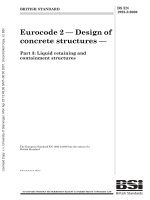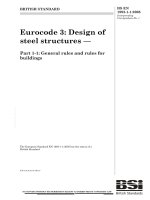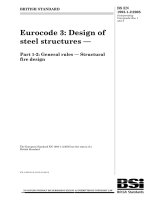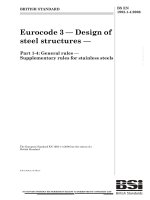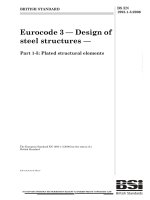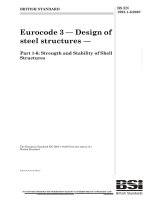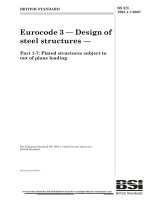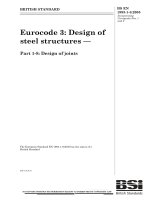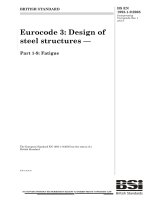Tiêu chuẩn Châu Âu EC3: Kết cấu thép phần 2: Thiết kế cầu thép (Eurocode3 BS EN1993 2 e 2006 Design of steel structures part 2: Steel bridges)
Bạn đang xem bản rút gọn của tài liệu. Xem và tải ngay bản đầy đủ của tài liệu tại đây (1.26 MB, 106 trang )
BRITISH STANDARD
Eurocode 3 — Design of
steel structures —
Part 2: Steel bridges
--`,`````,````,`,,`,,,``,,,``,-`-`,,`,,`,`,,`---
The European Standard EN 1993-2:2006 has the status of a
British Standard
ICS 91.010.30; 91.080.10; 93.040
12 &23<,1* :,7+287 %6, 3(50,66,21 (;&(37 $6 3(50,77(' %< &23<5,*+7 /$:
BS EN
1993-2:2006
BS EN 1993-2:2006
National foreword
This British Standard was published by BSI. It is the UK implementation of
EN 1993-2:2006. It partially supersedes BS 5400-3:2000. This standard will be
withdrawn by March 2010 at the latest.
The UK participation in its preparation was entrusted by Technical Committee
B/525, Building and civil engineering structures, to Subcommittee B/525/31,
Structural use of steel.
A list of organizations represented on B/525/31 can be obtained on request to
its secretary.
The structural Eurocodes are divided into packages by grouping Eurocodes for
each of the main materials: concrete, steel, composite concrete and steel,
timber, masonry and aluminium; this is to enable a common date of
withdrawal (DOW) for all the relevant parts that are needed for a particular
design. The conflicting national standards will be withdrawn at the end of the
coexistence period, after all the EN Eurocodes of a package are available.
Following publication of the EN, there is a period allowed for national
calibration during which the National Annex is issued, followed by a
coexistence period of a maximum three years. During the coexistence period
Member States are encouraged to adapt their national provisions. Conflicting
national standards will be withdrawn by March 2010 at the latest. Where a
normative part of this EN allows for a choice to be made at national level, the
range and possible choice will be given in the normative text, and a note will
qualify it as a Nationally Determined Parameter (NDP). NDPs can be a specific
value for a factor, a specific level or class, a particular method or a particular
application rule if several are proposed in the EN. To enable EN 1993-1-11 to
be used in the UK, the NDPs will be published in a National Annex, which will
be made available by BSI in due course after public consultation has taken
place.
This publication does not purport to include all the necessary provisions of a
contract. Users are responsible for its correct application.
Compliance with a British Standard cannot confer immunity from
legal obligations.
This British Standard was
published under the authority
of the Standards Policy and
Strategy Committee
on 30 November 2006
© BSI 2006
ISBN 0 580 49664 3
--`,`````,````,`,,`,,,``,,,``,-`-`,,`,,`,`,,`---
Amendments issued since publication
Amd. No.
Date
Comments
EUROPEAN STANDARD
EN 1993-2
NORME EUROPÉENNE
EUROPÄISCHE NORM
October 2006
ICS 91.010.30; 91.080.10; 93.040
Supersedes ENV 1993-2:1997
English Version
Eurocode 3 - Design of steel structures - Part 2: Steel Bridges
Eurocode 3 - Calcul des structures en acier - Partie 2:
Ponts métalliques
Eurocode 3 - Bemessung und konstruktion von Stahlbauten
- Teil 2: Stahlbrücken
This European Standard was approved by CEN on 9 January 2006.
CEN members are bound to comply with the CEN/CENELEC Internal Regulations which stipulate the conditions for giving this European
Standard the status of a national standard without any alteration. Up-to-date lists and bibliographical references concerning such national
standards may be obtained on application to the Central Secretariat or to any CEN member.
This European Standard exists in three official versions (English, French, German). A version in any other language made by translation
under the responsibility of a CEN member into its own language and notified to the Central Secretariat has the same status as the official
versions.
--`,`````,````,`,,`,,,``,,,``,-`-`,,`,,`,`,,`---
CEN members are the national standards bodies of Austria, Belgium, Cyprus, Czech Republic, Denmark, Estonia, Finland, France,
Germany, Greece, Hungary, Iceland, Ireland, Italy, Latvia, Lithuania, Luxembourg, Malta, Netherlands, Norway, Poland, Portugal, Romania,
Slovakia, Slovenia, Spain, Sweden, Switzerland and United Kingdom.
EUROPEAN COMMITTEE FOR STANDARDIZATION
COMITÉ EUROPÉEN DE NORMALISATION
EUROPÄISCHES KOMITEE FÜR NORMUNG
Management Centre: rue de Stassart, 36
© 2006 CEN
All rights of exploitation in any form and by any means reserved
worldwide for CEN national Members.
B-1050 Brussels
Ref. No. EN 1993-2:2006: E
EN 1993-2: 2006 (E)
Contents
1
--`,`````,````,`,,`,,,``,,,``,-`-`,,`,,`,`,,`---
2
General ..................................................................................................................................................... 9
1.1
1.2
1.3
1.4
1.5
1.6
1.7
Scope
Normative references
Assumptions
Distinction between principles and application rules
Terms and definitions
Symbols
Conventions for member axes
9
9
10
10
10
11
11
Basis of design ........................................................................................................................................ 11
2.1
2.2
2.3
2.4
2.5
3
Page
Requirements
Principles of limit state design
Basic variables
Verification by the partial factor method
Design assisted by testing
11
12
13
13
13
Materials................................................................................................................................................. 13
3.1
3.2
3.3
3.4
3.5
3.6
General
Structural steel
Connecting devices
Cables and other tension elements
Bearings
Other bridge components
13
13
15
16
16
16
4
Durability ............................................................................................................................................... 17
5
Structural analysis................................................................................................................................. 18
5.1
5.2
5.3
5.4
5.5
6
20
20
23
27
27
General
Calculation models
Limitations for stress
Limitation of web breathing
Limits for clearance gauges
Limits for visual impression
Performance criteria for railway bridges
Performance criteria for road bridges
Performance criteria for pedestrian bridges
Performance criteria for the effect of wind
Accessibility of joint details and surfaces
Drainage
28
28
29
29
30
30
30
30
31
31
31
31
Fasteners, welds, connections and joints ............................................................................................. 32
8.1
2
General
Resistance of cross sections
Buckling resistance of members
Built-up compression members
Buckling of plates
Serviceability limit states ...................................................................................................................... 28
7.1
7.2
7.3
7.4
7.5
7.6
7.7
7.8
7.9
7.10
7.11
7.12
8
18
18
19
19
19
Ultimate limit states............................................................................................................................... 20
6.1
6.2
6.3
6.4
6.5
7
Structural modelling for analysis
Global analysis
Imperfections
Methods of analysis considering material non-linearities
Classification of cross sections
Connections made of bolts, rivets and pins
32
EN 1993-2: 2006 (E)
8.2
9
Welded connections
34
Fatigue assessment................................................................................................................................. 36
9.1
9.2
9.3
9.4
9.5
9.6
9.7
10
General
Fatigue loading
Partial factors for fatigue verifications
Fatigue stress range
Fatigue assessment procedures
Fatigue strength
Post weld treatment
36
37
37
38
40
47
48
Design assisted by testing.................................................................................................................. 48
10.1 General
10.2 Types of tests
10.3 Verification of aerodynamic effects on bridges by testing
48
48
48
Annex A [informative] – Technical specifications for bearings ................................................................ 50
A.1
A.2
A.3
A.4
A.5
Scope
Symbols
General
Preparation of the bearing schedule
Supplementary rules for particular types of bearings
50
51
51
54
64
Annex B [informative] – Technical specifications for expansion joints for road bridges....................... 66
B.1 Scope
B.2 Technical specifications
B.3 Imposed loads, displacements and rotations from bridge movements
66
67
69
Annex C [informative] – Recommendations for the structural detailing of steel bridge decks ............. 70
C.1 Highway bridges
C.2 Railway bridges
C.3 Tolerances for semi-finished products and fabrication
70
80
83
Annex D [informative] – Buckling lengths of members in bridges and assumptions for geometrical
imperfections.................................................................................................................................................. 91
--`,`````,````,`,,`,,,``,,,``,-`-`,,`,,`,`,,`---
D.1 General
D.2 Trusses
D.3 Arched Bridges
91
91
96
Annex E [informative] – Combination of effects from local wheel and tyre loads and from global
traffic loads on road bridges....................................................................................................................... 101
E.1 Combination rule for global and local load effects
E.2 Combination factor
101
102
3
EN 1993-2: 2006 (E)
Foreword
This European Standard EN 1993-2, Eurocode 3: Design of steel structures Part 2: Steel bridges, has been
prepared by Technical Committee CEN/TC250 « Structural Eurocodes », the Secretariat of which is held by
BSI. CEN/TC250 is responsible for all Structural Eurocodes.
This European Standard shall be given the status of a National Standard, either by publication of an identical
text or by endorsement, at the latest by April 2007 and conflicting National Standards shall be withdrawn
at latest by March 2010.
This Eurocode supersedes ENV 1993-2.
According to the CEN-CENELEC Internal Regulations, the National Standard Organizations of the
following countries are bound to implement this European Standard: Austria, Belgium, Cyprus, Czech
Republic, Denmark, Estonia, Finland, France, Germany, Greece, Hungary, Iceland, Ireland, Italy, Latvia,
Lithuania, Luxembourg, Malta, Netherlands, Norway, Poland, Portugal, Romania, Slovakia, Slovenia, Spain,
Sweden, Switzerland and United Kingdom.
Background of the Eurocode programme
In 1975, the Commission of the European Community decided on an action programme in the field of
construction, based on article 95 of the Treaty. The objective of the programme was the elimination of
technical obstacles to trade and the harmonisation of technical specifications.
Within this action programme, the Commission took the initiative to establish a set of harmonised technical
rules for the design of construction works which, in a first stage, would serve as an alternative to the national
rules in force in the Member States and, ultimately, would replace them.
For fifteen years, the Commission, with the help of a Steering Committee with Representatives of Member
States, conducted the development of the Eurocodes programme, which led to the first generation of
European codes in the 1980’s.
In 1989, the Commission and the Member States of the EU and EFTA decided, on the basis of an agreement1
between the Commission and CEN, to transfer the preparation and the publication of the Eurocodes to the
CEN through a series of Mandates, in order to provide them with a future status of European Standard (EN).
This links de facto the Eurocodes with the provisions of all the Council’s Directives and/or Commission’s
Decisions dealing with European standards (e.g. the Council Directive 89/106/EEC on construction products
– CPD – and Council Directives 93/37/EEC, 92/50/EEC and 89/440/EEC on public works and services and
equivalent EFTA Directives initiated in pursuit of setting up the internal market).
The Structural Eurocode programme comprises the following standards generally consisting of a number of
Parts:
EN 1990 Eurocode 0: Basis of structural design
EN 1991 Eurocode 1: Actions on structures
EN 1992 Eurocode 2: Design of concrete structures
EN 1993 Eurocode 3: Design of steel structures
EN 1994 Eurocode 4: Design of composite steel and concrete structures
EN 1995 Eurocode 5: Design of timber structures
EN 1996 Eurocode 6: Design of masonry structures
EN 1997 Eurocode 7: Geotechnical design
1
Agreement between the Commission of the European Communities and the European Committee for Standardisation (CEN)
concerning the work on EUROCODES for the design of building and civil engineering works (BC/CEN/03/89).
--`,`````,````,`,,`,,,``,,,``,-`-`,,`,,`,`,,`---
4
EN 1993-2: 2006 (E)
EN 1998 Eurocode 8: Design of structures for earthquake resistance
EN 1999 Eurocode 9: Design of aluminium structures
Eurocode standards recognise the responsibility of regulatory authorities in each Member State and have
safeguarded their right to determine values related to regulatory safety matters at national level where these
continue to vary from State to State.
Status and field of application of Eurocodes
The Member States of the EU and EFTA recognise that Eurocodes serve as reference documents for the
following purposes :
–
as a means to prove compliance of building and civil engineering works with the essential requirements
of Council Directive 89/106/EEC, particularly Essential Requirement N°1 - Mechanical resistance and
stability - and Essential Requirement N°2 - Safety in case of fire;
–
as a basis for specifying contracts for construction works and related engineering services;
–
as a framework for drawing up harmonised technical specifications for construction products (ENs and
ETAs)
The Eurocodes, as far as they concern the construction works themselves, have a direct relationship with the
Interpretative Documents2 referred to in Article 12 of the CPD, although they are of a different nature from a
harmonised product standard3. Therefore, technical aspects arising from the Eurocodes work need to be
adequately considered by CEN Technical Committees and/or EOTA Working Groups working on product
standards with a view to achieving a full compatibility of these technical specifications with the Eurocodes.
The Eurocode standards provide common structural design rules for everyday use for the design of whole
structures and component products of both a traditional and an innovative nature. Unusual forms of
construction or design conditions are not specifically covered and additional expert consideration will be
required by the designer in such cases.
National Standards implementing Eurocodes
The National Standards implementing Eurocodes will comprise the full text of the Eurocode (including any
annexes), as published by CEN, which may be preceded by a National title page and National foreword, and
may be followed by a National annex (informative).
–
values for partial factors and/or classes where alternatives are given in the Eurocode,
–
values to be used where a symbol only is given in the Eurocode,
–
geographical and climatic data specific to the Member State, e.g. snow map,
–
the procedure to be used where alternative procedures are given in the Eurocode,
–
references to non-contradictory complementary information to assist the user to apply the Eurocode.
2
According to Art. 3.3 of the CPD, the essential requirements (ERs) shall be given concrete form in interpretative documents for the
creation of the necessary links between the essential requirements and the mandates for hENs and ETAGs/ETAs.
3
According to Art. 12 of the CPD the interpretative documents shall :
a) give concrete form to the essential requirements by harmonising the terminology and the technical bases and indicating classes
or levels for each requirement where necessary ;
b) indicate methods of correlating these classes or levels of requirement with the technical specifications, e.g. methods of
calculation and of proof, technical rules for project design, etc. ;
c) serve as a reference for the establishment of harmonised standards and guidelines for European technical approvals.
The Eurocodes, de facto, play a similar role in the field of the ER 1 and a part of ER 2.
5
--`,`````,````,`,,`,,,``,,,``,-`-`,,`,,`,`,,`---
The National Annex (informative) may only contain information on those parameters which are left open in
the Eurocode for national choice, known as Nationally Determined Parameters, to be used for the design of
buildings and civil engineering works to be constructed in the country concerned, i.e. :
EN 1993-2: 2006 (E)
Links between Eurocodes and product harmonised technical specifications (ENs
and ETAs)
There is a need for consistency between the harmonised technical specifications for construction products
and the technical rules for works4. Furthermore, all the information accompanying the CE Marking of the
construction products which refer to Eurocodes should clearly mention which Nationally Determined
Parameters have been taken into account.
Additional information specific to EN 1993-2
EN 1993-2 is the second part of six parts of EN 1993 – Design of Steel Structures – and describes the
principles and application rules for the safety and serviceability and durability of steel structures for bridges.
EN 1993-2 gives design rules which are supplementary to the generic rules in EN 1993-1-1.
EN 1993-2 is intended to be used with Eurocodes EN 1990 – Basis of design, EN 1991 – Actions on
structures and the parts 2 of EN 1992 to EN 1998 when steel structures or steel components for bridges are
referred to.
Matters that are already covered in those documents are not repeated.
EN 1993-2 is intended for use by
–
committees drafting design related product, testing and execution standards,
–
clients (e.g. for the formulation of their specific requirements),
–
designers and constructors,
–
relevant authorities.
Numerical values for partial factors and other reliability parameters are recommended as basic values that
provide an acceptable level of reliability. They have been selected assuming that an appropriate level of
workmanship and quality management applies.
National annex for EN 1993-2
This standard gives alternative procedures, values and recommendations with notes indicating where national
choices may have to be made. The National Standard implementing EN 1993-2 should have a National
Annex containing all Nationally Determined Parameters to be used for the design of steel structures to be
constructed in the relevant country.
National choice is allowed in EN 1993-2 through:
–
2.1.3.2(1)
–
2.1.3.3(5)
–
2.1.3.4(1)
–
2.1.3.4(2)
–
2.3.1(1)
–
3.2.3(2)
–
3.2.3(3)
–
3.2.4(1)
–
3.4(1)
–
3.5(1)
–
3.6(1)
4
6
See Art.3.3 and Art.12 of the CPD, as well as clauses 4.2, 4.3.1, 4.3.2 and 5.2 of ID 1.
--`,`````,````,`,,`,,,``,,,``,-`-`,,`,,`,`,,`---
–
–
–
--`,`````,````,`,,`,,,``,,,``,-`-`,,`,,`,`,,`---
–
EN 1993-2: 2006 (E)
3.6(2)
4(1)
4(4)
5.2.1(4)
–
5.4.1(1)
–
6.1(1)P
–
6.2.2.3(1)
–
6.2.2.4(1)
–
6.3.2.3(1)
–
6.3.4.2(1)
–
6.3.4.2(7)
–
7.1(3)
–
7.3(1)
–
7.4(1)
–
8.1.3.2.1(1)
–
8.1.6.3(1)
–
8.2.1.4(1)
–
8.2.1.5(1)
–
8.2.1.6(1)
–
8.2.10(1)
–
8.2.13(1)
–
8.2.14(1)
–
9.1.2(1)
–
9.1.3(1)
–
9.3(1)P
–
9.3(2)P
–
9.4.1(6)
–
9.5.2(2)
–
9.5.2(3)
–
9.5.2(5)
–
9.5.2(6)
–
9.5.2(7)
–
9.5.3(2) (two places)
–
9.6(1) (two places)
–
9.7(1)
–
A.3.3(1)P
–
A.3.6(2)
–
A.4.2.1(2)
–
A.4.2.1(3)
–
A.4.2.1(4)
–
A.4.2.4(2)
–
C.1.1(2)
7
EN 1993-2: 2006 (E)
–
C.1.2.2(1)
–
C.1.2.2(2)
–
E.2(1)
--`,`````,````,`,,`,,,``,,,``,-`-`,,`,,`,`,,`---
8
EN 1993-2: 2006 (E)
1 General
1.1 Scope
1.1.1
(1)
1.1.2
Scope of Eurocode 3
See 1.1.1(1), (2), (3), (4), (5) and (6) of EN 1993-1-1.
Scope of Part 2 of Eurocode 3
--`,`````,````,`,,`,,,``,,,``,-`-`,,`,,`,`,,`---
(1) EN 1993-2 provides a general basis for the structural design of steel bridges and steel parts of
composite bridges. It gives provisions that supplement, modify or supersede the equivalent provisions given
in the various parts of EN 1993-1.
(2)
The design criteria for composite bridges are covered in EN 1994-2.
(3)
The design of high strength cables and related parts are included in EN 1993-1-11.
(4) This European Standard is concerned only with the resistance, serviceability and durability of bridge
structures. Other aspects of design are not considered.
(5)
For the execution of steel bridge structures, EN 1090 should be taken into account.
NOTE: As long as EN 1090 is not yet available a provisional guidance is given in Annex C.
(6) Execution is covered to the extent that is necessary to indicate the quality of the construction materials
and products that should be used and the standard of workmanship needed to comply with the assumptions of
the design rules.
(7) Special requirements of seismic design are not covered. Reference should be made to the requirements
given in EN 1998, which complements and modifies the rules of EN 1993-2 specifically for this purpose.
1.2 Normative references
(1) This European Standard incorporates, by dated or undated reference, provisions from other
publications. These normative references are cited at the appropriate places in the text and the publications
are listed hereafter. For dated references, subsequent amendments to or revisions of any of these publications
apply to this European Standard only when incorporated in it by amendment or revision. For undated
references the latest edition of the publication applies (including amendments).
(2) In addition to the normative references given in EN 1990 and EN 1993-1 the following references
should apply:
EN 1090
Execution of steel structures and aluminium structures
EN 1337
Structural bearings
EN 10029:1991
Specification for tolerances on dimensions, shape and mass for hot rolled steel plates 3
mm thick or above.
EN 10164
Steel products with improved deformation properties perpendicular to the surface of the
product - Technical delivery conditions.
EN ISO 5817
Arc-welded joints in steel - Guidance on quality levels for imperfections.
EN ISO 12944-3
Paints and varnishes - Corrosion protection of steel structures by protective paint
systems - Design considerations.
EN ISO 9013:2002 Thermal cutting - Classification of thermal cuts - Geometrical product specification and
quality tolerances.
9
EN 1993-2: 2006 (E)
EN ISO 15613
Specification and qualification of welding procedures for metallic materials Qualification based on pre-production welding test
EN ISO 15614-1
Specification and qualification of welding procedures for metallic materials - Welding
procedure test - Part 1: Arc and gas welding of steels and arc welding of nickel and
nickel alloys
1.3 Assumptions
(1)
See 1.3(1) of EN 1993-1-1.
1.4 Distinction between principles and application rules
See 1.4(1) of EN 1993-1-1.
1.5 Terms and definitions
(1)
The terms and definitions given in EN 1990, EN 1993-1 and the following apply:
1.5.1
bridges
civil engineering construction works mainly intended to carry traffic or pedestrian loads over a natural
obstacle or a communication line
NOTE: Railway bridges and bridges which carry canals, service pipes or other vehicles such as an aircraft are
also covered.
1.5.2
abutment
any end support of a bridge
NOTE: A distinction is made between rigid abutments and flexible abutments where relevant.
1.5.3
integral abutment
abutment that is connected to the deck without any movement joint
1.5.4
pier
intermediate support of a bridge, situated under the deck
1.5.5
bearing
structural support located between the superstructure and an abutment or pier of the bridge that transfers
loads from the deck to the abutment or pier
1.5.6
cable stay
tensioned element which connects the deck of a bridge to the pylon or pylons above the deck
1.5.7
prestress
permanent effect due to controlled forces and /or controlled deformations imposed within a structure
NOTE: Various types of prestress are distinguished from each other as relevant (such as prestress by tendons or
prestress by imposed deformation of supports).
1.5.8
headroom
clear height available for traffic
10
--`,`````,````,`,,`,,,``,,,``,-`-`,,`,,`,`,,`---
(1)
EN 1993-2: 2006 (E)
1.5.9
breathing (of plates)
out-of-plane deformation of a plate caused by repeated application of in-plane loading
1.5.10
secondary structural elements
structural elements that do not form part of the main structure of the bridge
NOTE: The secondary structural elements are provided for other reasons, such as guard rails, parapets, ladders
and access covers.
1.6 Symbols
(1)
The symbols in EN 1990 und EN 1993-1 apply. Further symbols are given as follows:
σEd,ser, τEd,ser
nominal stresses from the characteristic load combination
λ, λ1, λ2, λ3, λ4, λmax, λloc, λglo damage equivalent factors
damage equivalent impact factors
∆σp, ∆σloc, ∆σglo
stress ranges from load p
µk
characteristic value of friction coefficient
γµ
partial factor for friction
α
factor depending on type of bearing and number of bearings with adverse or
relieving forces
T0max, T0min, T0
temperatures
∆T0, ∆TK, ∆Tγ
temperature differences
γT
partial factor for temperature
K, Kfoundation, Kpier, Kbearing
spring stiffness
S d, S T
slide path
(2)
--`,`````,````,`,,`,,,``,,,``,-`-`,,`,,`,`,,`---
Φ2, Φloc, Φglo
Additional symbols are defined in the text where they first occur.
1.7 Conventions for member axes
(1)
See 1.7(1), (2), (3) and (4) of EN 1993-1-1.
2 Basis of design
2.1 Requirements
2.1.1
(1)
Basic requirements
See 2.1.1(1), (2) and (3) of EN 1993-1-1.
2.1.2
(1)
Reliability management
See 2.1.2(1) of EN 1993-1-1.
2.1.3
Design working life, durability and robustness
2.1.3.1
(1)
General
See 2.1.3.1(1) of EN 1993-1-1.
(2)P Bridges shall be designed for fatigue for the duration of their design working life.
11
EN 1993-2: 2006 (E)
2.1.3.2
Design working life
(1) The design working life should be taken as the period for which a bridge is required to be used for its
intended purpose, taking into account anticipated maintenance but not major repair.
NOTE 1: The National Annex may specify the design working life. A design working life of a permanent
bridge of 100 years is recommended.
NOTE 2: For temporary bridges the design working life may be stated in the project specifications.
(2)
For structural elements that cannot be designed for the total design life of the bridge, see 2.1.3.3.
2.1.3.3
Durability
(1) To ensure durability, bridges and their components may be designed to minimise damage or be
protected from excessive deformation, deterioration, fatigue and accidental actions that are expected during
the design working life.
(2) Structural parts of a bridge to which guardrails or parapets are connected, should be designed to ensure
that plastic deformations of the guardrails or parapets can occur without damaging the structure.
(3) Where a bridge includes components that need to be replaceable, see 4(6), the possibility of their safe
replacement should be verified as a transient design situation.
--`,`````,````,`,,`,,,``,,,``,-`-`,,`,,`,`,,`---
(4) Permanent connections of structural parts of the bridge should be made with preloaded bolts in a
Category B or C connection. Alternatively closely fitted bolts, rivets or welding may be used to prevent
slipping.
(5) Joints where the transmission of forces is purely by contact may be used where justified by fatigue
assessments.
NOTE: The National Annex may give additional recommendations for durable details.
2.1.3.4
Robustness and structural integrity
(1) The design of the bridge should ensure that when the damage of a component due to accidental actions
occurs, the remaining structure can sustain at least the accidental load combination with reasonable means.
NOTE: The National Annex may define components that are subject to accidental design situations and also
details for assessments. Examples of such components are hangers, cables, bearings.
(2) The effects of corrosion or fatigue of components and material should be taken into account by
appropriate detailing, see also EN 1993-1-9 and EN 1993-1-10.
NOTE 1: EN 1993-1-9, section 3 provides assessment methods using the principles of damage tolerance or safe
life.
NOTE 2: The National Annex may give a choice of the design method to be used for fatigue assessment.
NOTE 3: For guidance on access, maintenance and inspection, see section 4.
2.2 Principles of limit state design
(1)
See 2.2(1) and (2) of EN 1993-1-1.
(3) For damage limitation at the ultimate limit state global analysis models should be elastic for transient
and persistent design situations, see 5.4.
12
EN 1993-2: 2006 (E)
(4) The required fatigue life should be achieved through design for fatigue and/or appropriate detailing,
see Annex C, and by serviceability checks.
2.3 Basic variables
2.3.1
Actions and environmental influences
(1) Actions for the design of bridges should be taken from EN 1991. For the combination of actions and
partial factors for actions see Annex A.2 of EN 1990.
NOTE 1: For actions on steel bridge decks of road bridges, see Annex E.
NOTE 2: For actions not specified in EN 1991, see the National Annex.
(2)
See 2.3(2), (3), (4) and (5) of EN 1993-1-1.
NOTE: For actions on bearings, see Annex A.
2.3.2
(1)
Material and product properties
See 2.3.2(1) of EN 1993-1-1.
2.4 Verification by the partial factor method
(1)
See 2.4.1(1), 2.4.2(1) and (2), 2.4.3(1) and 2.4.4(1) of EN 1993-1-1.
(1)
--`,`````,````,`,,`,,,``,,,``,-`-`,,`,,`,`,,`---
2.5 Design assisted by testing
See 2.5(1), (2) and (3) of EN 1993-1-1.
3 Materials
3.1 General
(1)
See 3.1(1) and (2) of EN 1993-1-1.
3.2 Structural steel
3.2.1
(1)
3.2.2
(1)
Material properties
See 3.2.1(1) of EN 1993-1-1.
Ductility requirements
See 3.2.2(1) and (2) of EN 1993-1-1.
13
EN 1993-2: 2006 (E)
3.2.3
Fracture toughness
(1) The material should have the required material toughness to prevent brittle fracture within the intended
design working life of the structure.
(2) No further checks against brittle fracture need to be made if the conditions given in EN 1993-1-10 are
met for the lowest service temperature.
NOTE 1: The lowest service temperature to be adopted in design may be taken from EN 1991-1-5.
NOTE 2: The National Annex may specify additional requirements depending on the plate thickness. An
example is given in Table 3.1.
Table 3.1: Example for additional requirement for toughness of base material
Example
Nominal thickness
t ≤ 30 mm
1
30 < t ≤ 80 mm
t > 80 mm
(3)
Additional requirement
T27J = -20 °C in accordance with EN 10025
Fine grain steel in accordance with EN 10025, e.g.
S355N/M
Fine grain steel in accordance with EN 10025, e.g.
S355NL/ML
For bridge components under compression a suitable minimum toughness property should be selected.
NOTE: The National Annex may give guidance on the selection of toughness properties for members in
compression. The use of Table 2.1 of EN 1993-1-10 for σEd = 0,25 fy(t) is recommended.
Through thickness properties
(1) Steel with improved through thickness properties forming to EN 10164 should be used where
required, see EN 1993-1-10.
NOTE: Where ZEd values have been determined in accordance with EN 1993-1-10, the required quality class
according to EN 10164 may be chosen in the National Annex. The choice in Table 3.2 is recommended.
Table 3.2: Quality class conforming to EN 10164
Target value ZEd
ZEd ≤ 10
10 < ZEd ≤ 20
20 < ZEd ≤ 30
ZEd > 30
3.2.5
Quality class
–
Z15
Z25
Z35
Tolerances
(1) The dimensional and mass tolerances of rolled steel sections, structural hollow sections and plates
should conform with the relevant product standard, ETAG or ETA unless more severe tolerances are
specified.
(2)
For welded components the tolerances in EN 1090 should be applied.
(3)
See 3.2.5(3) of EN 1993-1-1.
3.2.6
(1)
14
Design values of material coefficients
See 3.2.6(1) of EN 1993-1-1.
--`,`````,````,`,,`,,,``,,,``,-`-`,,`,,`,`,,`---
3.2.4
EN 1993-2: 2006 (E)
3.3 Connecting devices
3.3.1
Fasteners
3.3.1.1
Bolts, nuts and washers
(1) Bolts, nuts and washers should conform to the Reference Standards given in EN 1993-1-8, 2.8:
Group 4.
(2)
The rules in this part are applicable to bolts of grades given in Table 3.3.
(3) The nominal values of the yield strength fyb and the ultimate tensile strength fub are given in Table 3.3
and they should be adopted as characteristic values in calculations.
Table 3.3: Nominal values of the yield strength fyb and the ultimate tensile
strength fub for bolts
Bolt grade
4.6
5.6
6.8
8.8
10.9
fyb (N/mm2)
240
300
480
640
900
fub (N/mm2)
400
500
600
800
1000
3.3.1.2
Preloaded bolts
(1) High strength structural bolts of bolt grades 8.8 and 10.9 which conform to the Reference standards
given in EN 1993-1-8, 2.8: Group 4 may be used as preloaded bolts when controlled tightening is carried out
in accordance with the Reference Standards given in EN 1993-1-8, 2.8: Group 7.
3.3.1.3
Rivets
(1) The material properties, dimensions and tolerances of steel rivets should conform to the Reference
Standards given in EN 1993-1-8, 2.8: Group 6.
3.3.1.4
(1)
Anchor bolts
The following steel grades may be used for anchor bolts:
–
Steel grades in accordance with the appropriate Reference Standards given in EN 1993-1-8, 2.8:
Group 1;
–
Steel grades in accordance with the appropriate Reference Standards given in EN 1993-1-8, 2.8:
Group 4;
–
Reinforcing bars conforming to EN 10080.
The nominal yield strength for anchor bolts should not exceed 640 N/mm2.
3.3.2
Welding consumables
(1) All welding consumables should conform to the Reference Standards given in EN 1993-1-8, 2.8:
Group 5.
(2) The performance of the weld metal should not be less than the corresponding values specified for steel
grade being welded. This should take into account:
–
specified yield strength;
–
ultimate tensile strength;
–
elongation at failure;
–
minimum Charpy V-notch energy value of the filler metal.
--`,`````,````,`,,`,,,``,,,``,-`-`,,`,,`,`,,`---
15
EN 1993-2: 2006 (E)
3.4 Cables and other tension elements
(1)
For cables and other tension elements see EN 1993-1-11.
NOTE: The National Annex may specify the types of cables appropriate to the specific bridge types.
3.5 Bearings
(1)
Bearings should conform to EN 1337.
NOTE: The National Annex may give guidance on the types of bearings applicable to bridges.
3.6 Other bridge components
(1) Expansion joints, guardrails, parapets and other ancillary items should conform to the relevant
technical specifications.
NOTE: The National Annex may give guidance on the types of expansion joint, guardrail, parapet and other
ancillary items applicable to bridges.
(2) The bridge deck surfacing system, the products used and the method of application should meet with
the relevant technical specification.
NOTE: The National Annex may give guidance on the bridge deck surfacing system, the products used and the
method of application applicable to bridges.
--`,`````,````,`,,`,,,``,,,``,-`-`,,`,,`,`,,`---
16
EN 1993-2: 2006 (E)
4 Durability
(1)
See 4(1), (2) and (3) of EN 1993-1-1.
NOTE: The National Annex may give guidance on requirements for access to allow for inspection and
maintenance.
(4) For elements that cannot be inspected fatigue checks should be carried out (see EN 1993-1-9) and
appropriate corrosion allowances should be provided.
NOTE: The National Annex may give guidance on sealing against corrosion, measures to ensure air tightness
of box girders or the provisions of extra steel thickness for inaccessible surfaces.
The required fatigue life of the structure and its components should be attained by the:
–
fatigue design of details in accordance with (1), (4) and EN 1993-1-9 and with serviceability checks
carried out in accordance with section 7;
–
structural detailing for orthotropic steel decks;
–
material chosen in accordance with section 3;
–
fabrication conforming to EN 1090.
(6) Components that cannot be designed with sufficient reliability to achieve the total design working life
of the bridge should be replaceable. These may include:
–
stays, cables, hangers;
–
bearings;
–
expansion joints;
–
drainage devices;
–
guardrails, parapets;
–
asphalt layer and other surface protection;
–
wind shields;
–
noise barriers.
17
--`,`````,````,`,,`,,,``,,,``,-`-`,,`,,`,`,,`---
(5)
EN 1993-2: 2006 (E)
5 Structural analysis
5.1 Structural modelling for analysis
5.1.1
Structural modelling and basic assumptions
(1)
See 5.1.1(1), (2) and (3) of EN 1993-1-1.
(4)
For the structural modelling and basic assumptions for components of bridges see EN 1993-1-1.
NOTE: For the design of plated components and cables see also EN 1993-1-5 and EN 1993-1-11.
5.1.2
(1)
Joint modelling
See 5.1.2(1), (2), (3) and (4) of EN 1993-1-1 and EN 1993-1-8.
(5) For bridges, the type of joint and its modelling should be chosen to ensure that the required fatigue life
can be attained.
NOTE: Rigid joints appropriate to the fatigue categories given in EN 1993-1-9 are suitable to be employed
between members of bridges except for bearings or pinned connections or cables.
5.1.3
(1)
Ground structure interaction
See 5.1.3(1) of EN 1993-1-1.
NOTE 2: The stiffness of the supports may be based on the deformation characteristics of the bearings, piers
and foundation.
5.2 Global analysis
5.2.1
(1)
Effects of deformed geometry of the structure
See 5.2.1(1), (2) and (3) of EN 1993-1-1.
(4) The bridges and components may be checked with first order theory if the following criterion is
satisfied for each section:
α cr ≥ 10
(5.1)
where αcr
is defined in 5.2.1(3) of EN 1993-1-1
NOTE: The National Annex may give further guidance for the definition and calculation of αcrit.
(5)
5.2.2
(1)
See 5.2.1(5) and (6) of EN 1993-1-1.
Structural stability of frames
See 5.2.2(1), (2), (3) and (4) of EN 1993-1-1.
(5) Where the behaviour of a bridge or its components is governed by the first buckling mode (single
degree of freedom) the second order effects MII may be calculated by applying a factor to the bending
moments MI as follows:
1
M II = M I
1−
(5.2)
1
α cr
where αcr > 3.
18
--`,`````,````,`,,`,,,``,,,``,-`-`,,`,,`,`,,`---
EN 1993-2: 2006 (E)
(6)
See 5.2.2(7) and (8) of EN 1993-1-1.
5.3 Imperfections
5.3.1
(1)
5.3.2
(1)
Basis
See 5.3.1(1), (2) and (3) of EN 1993-1-1.
Imperfections for global analysis of frames
See 5.3.2(1), (2) and (3) of EN 1993-1-1.
NOTE 1: For piers αm would be applicable, if cumulative effects from contributions of various piers occur (e.g.
for piers forming a frame with the superstructure).
NOTE 2: For the use of member imperfections see also Annex D.
(4)
5.3.3
(1)
5.3.4
(1)
See 5.3.2(6), (7), (8), (10) and (11) of EN 1993-1-1.
Imperfection for analysis of bracing systems
See 5.3.3(1), (2), (3), (4) and (5) of EN 1993-1-1.
Member imperfections
See 5.3.4(1), (2) and (3) of EN 1993-1-1.
5.4 Methods of analysis considering material non-linearities
5.4.1
General
(1) Elastic analysis should be used to determine the internal forces and moments for all persistent and
transient design situations.
NOTE: The National Annex may give guidance to enable the user to determine when a plastic global analysis
may be used for accidental design situations. For plastic global analysis see 5.4 and 5.5 of EN 1993-1-1.
5.4.2
(1)
Elastic global analysis
See 5.4.2(1), (2) and (3) of EN 1993-1-1.
(4) If all sections are class 1 the effects of differential temperature, shrinkage and settlement at the
ultimate limit state may be ignored.
5.5 Classification of cross sections
5.5.1
(1)
5.5.2
(1)
Basis
See 5.5.1(1) of EN 1993-1-1.
Classification
See 5.5.2(1), (2), (3), (4), (5), (6), (7), (8), (9) and (10) of EN 1993-1-1.
--`,`````,````,`,,`,,,``,,,``,-`-`,,`,,`,`,,`---
19
EN 1993-2: 2006 (E)
6 Ultimate limit states
6.1 General
(1)P The partial factors γM as defined in 2.4.3 of EN 1993-1-1 shall be applied to the various characteristic
values of resistance in this section, see Table 6.1:
a) resistance of members and cross section:
–
resistance of cross sections to excessive yielding including local buckling
γM0
–
resistance of members to instability assessed by member checks
γM1
–
resistance of cross sections in tension to fracture
γM2
b) resistance of joints
–
resistance of bolts
–
resistance of rivets
–
resistance of pins
–
resistance of welds
–
resistance of plates in bearing
–
slip resistance
–
at ultimate limit state (Category C)
–
at serviceability limit state
γM2
γM3
γM3,ser
–
bearing resistance of an injection bolt
γM4
–
resistance of joints in hollow section lattice girders
γM5
–
resistance of pins at serviceability limit state
–
preload of high strength bolts
γM6,ser
γM7
NOTE 1: For the partial factor γc for the resistance of concrete see EN 1992.
NOTE 2: The partial factors γMi for bridges may be defined in the National Annex. The following numerical
values are recommended:
γM0 = 1,00
γM1 = 1,10
γM2 = 1,25
γM3 = 1,25
γM3,ser = 1,10
γM4 = 1,10
γM5 = 1,10
γM6,ser = 1,00
γM7 = 1,10
6.2 Resistance of cross sections
6.2.1
(1)
20
General
See 6.2.1(1), (2), (3), (4), (5), (6), (7), (8), (9) and (10) of EN 1993-1-1.
--`,`````,````,`,,`,,,``,,,``,-`-`,,`,,`,`,,`---
Table 6.1: Partial factors
EN 1993-2: 2006 (E)
6.2.2
Section properties
6.2.2.1
(1)
See 6.2.1.1(1) of EN 1993-1-1.
6.2.2.2
(1)
Gross cross section
Net area
See 6.2.2.2(1), (2), (3), (4) and (5) of EN 1993-1-1.
6.2.2.3
(1)
Shear lag effects
See 6.2.2.3(1) and (2) of EN 1993-1-1 and 3.2 and 3.3 of EN 1993-1-5.
NOTE: The National Annex may give guidance on the treatment of shear lag effects at the ultimate limit state.
6.2.2.4
See 6.2.2.4(1) of EN 1993-1-1
6.2.2.5
Effects of local buckling for class 4 cross sections
(1) The effects of local buckling should be considered using one of the following two methods specified
in EN 1993-1-5:
1. effective cross section properties of class 4 sections in accordance with EN 1993-1-5, section 4
2. limiting the stress levels to achieve cross section properties in accordance with EN 1993-1-5, section 10
NOTE: The National Annex may recommend which method is to be used. In case of the use of the method 2
the National Annex may give further guidance.
6.2.2.6
Effective cross section properties of class 4 sections
(1)
See 6.2.2.5(1), (2), (3), (4) and (5) of EN 1993-1-1.
(2)
For stress limits of circular hollow sections to conform to class 3 section properties, see EN 1993-1-6.
6.2.3
(1)
6.2.4
(1)
Tension
See 6.2.3(1), (2), (3), (4) and (5) of EN 1993-1-1.
Compression
See 6.2.4(1) of EN 1993-1-1.
(2) The design resistance of cross sections for uniform compression Nc,Rd should be determined as
follows:
a) without local buckling:
N c , Rd =
A fy
γM0
for class 1, 2 and 3 cross sections
(6.1)
b) with local buckling:
N c , Rd =
N c , Rd =
Aeff f y
γM0
A σ limit
γM0
for class 4 cross sections or
(6.2)
for stress limits
(6.3)
21
--`,`````,````,`,,`,,,``,,,``,-`-`,,`,,`,`,,`---
(1)
Effective properties of cross section with class 3 webs and Class 1 or 2 flanges
EN 1993-2: 2006 (E)
where σlimit = ρx fy
(3)
is the limiting stress of the weakest part of the cross section in compression (see
10(5) of EN 1993-1-5)
See 6.2.4(3) and (4) of EN 1993-1-1.
6.2.5
Bending moment
(1)
See 6.2.5(1) of EN 1993-1-1.
(2)
The design resistance for bending about the major axis should be determined as follows:
a) without local buckling:
M c , Rd =
M c ,Rd =
W pl f y
γM0
for class 1 and 2 cross sections
(6.4)
for class 3 cross sections
(6.5)
for class 4 cross sections or
(6.6)
Wel ,min f y
γM0
b) with local buckling:
M c ,Rd =
M c ,Rd =
Weff ,min f y
γM0
Wel ,min σ limit
γM0
where Wel,min and Weff,min
for stress limits
(6.7)
are the elastic moduli which correspond to the fibre with the maximum elastic
stress
σlimit is the limiting stress of the weakest part of the cross section in compression (see 2.4 of
EN 1993-1-5)
(3)
See 6.2.5(3), (4), (5) and (6) of EN 1993-1-1.
6.2.6
Shear
(1)
See 6.2.6(1), (2), (3), (4), (5), (6), (7) and (8) of EN 1993-1-1 and section 5 of EN 1993-1-5.
6.2.7
Torsion
6.2.7.1
(1)
General
Torsional and distortional effects should be taken into account for members subject to torsion.
(2) The effects of transverse stiffness in the cross section, or of diaphragms that are built in to reduce
distortional deformations, may be taken into account by considering an appropriate elastic model which is
subject to the combined effect of bending, torsion and distortion.
(3) Distortional effects in the members may be disregarded where the effects from distortion, due to the
transverse bending stiffness in the cross section and/or diaphragm action, do not exceed 10 % of the bending
effects.
(4) Diaphragms should be designed to take into account the action effects resulting from their load
distributing effect.
6.2.7.2
(1)
Torsion for which distortional effects may be neglected
See 6.2.7(1), (2), (3), (4), (5), (6), (7), (8), and (9) of EN 1993-1-1.
--`,`````,````,`,,`,,,``,,,``,-`-`,,`,,`,`,,`---
22
EN 1993-2: 2006 (E)
6.2.8
Bending, axial load, shear and transverse loads
(1) The interaction between bending, axial load, shear and transverse loads may be determined using one
of the following two methods:
1. Interaction methods given in 6.2.8 to 6.2.10.
NOTE: For local buckling effects see EN 1993-1-5, section 4 to 7.
2. Interaction of stresses using the yielding criterion given in 6.2.1
NOTE: For local buckling effects EN 1993-1-5, see section 10.
6.2.9
(1)
Bending and shear
See 6.2.8(1), (2), (3), (4), (5) and (6) of EN 1993-1-1.
6.2.10 Bending and axial force
6.2.10.1 Class 1 and class 2 cross sections
(1)
See 6.2.9.1(1), (2), (3), (4), (5) and (6) of EN 1993-1-1.
6.2.10.2 Class 3 cross sections
(1)
See 6.2.9.2(1) of EN 1993-1-1.
(2)
The following should be met for local buckling consideration, when the limit stress method is used:
σ x , Ed ≤
--`,`````,````,`,,`,,,``,,,``,-`-`,,`,,`,`,,`---
σ limit
fy
≤
γ M0 γ M0
(6.8)
where σlimit should be determined from section 10 of EN 1993-1-5.
6.2.10.3 Class 4 cross sections
(1)
See 6.2.9.3(1) and (2) of EN 1993-1-1.
6.2.11 Bending, shear and axial force
(1)
See 6.2.10(1), (2) and (3) of EN 1993-1-1.
6.3 Buckling resistance of members
6.3.1
Uniform members in compression
6.3.1.1
(1)
See 6.3.1.1(1), (2), (3) and (4) of EN 1993-1-1.
6.3.1.2
(1)
Slenderness for flexural buckling
See 6.3.1.3(1) and (2) of EN 1993-1-1.
6.3.1.4
(1)
Buckling curves
See 6.3.1.2(1), (2), (3) and (4) of EN 1993-1-1.
6.3.1.3
(1)
Buckling resistance
Slenderness for torsional and torsional flexural buckling
See 6.3.1.4(1), (2) and (3) of EN 1993-1-1.
23
